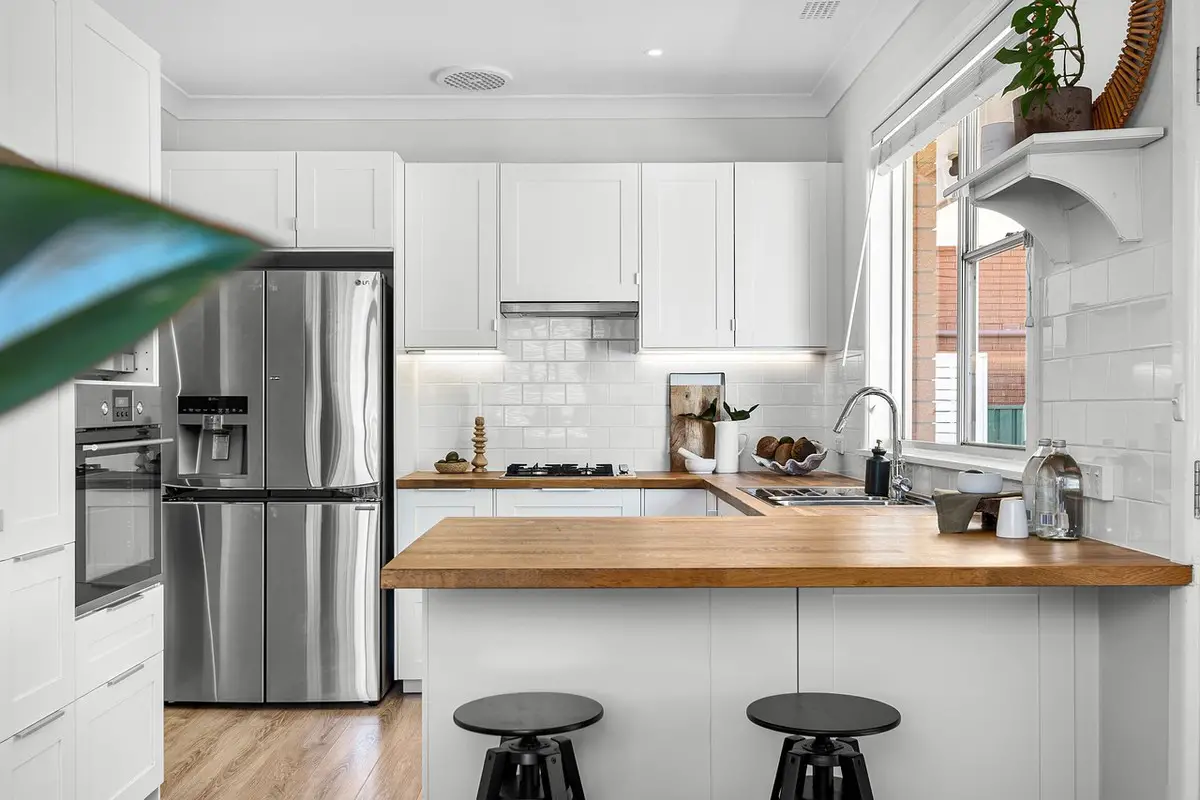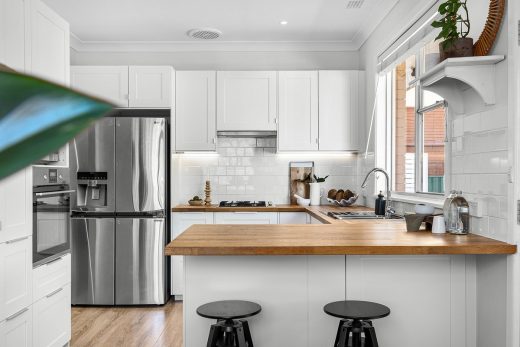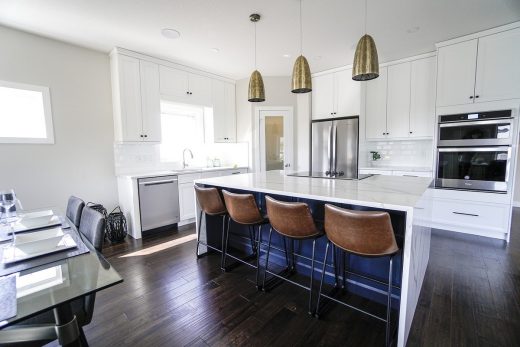Modern kitchens aesthetics and functionality, Property interior decor, House style guide
The Art of Modern Kitchens: Combining Aesthetics with Functionality
22 June 2024
This article was sent to us by Lilly Therry – [email protected]
for sheinerconstruction.com
but failed to complete the deal
Do not work with these people
The modern kitchen has evolved into much more than a space for cooking. It is now a central hub for family life, socializing, and even entertainment. This transformation is reflected in contemporary kitchen designs, which strive to combine aesthetics with functionality, creating a space that is both beautiful and practical.
The emphasis on clean lines, minimalist styles, and innovative storage solutions defines the modern kitchen. Designers aim to create environments that enhance the user experience through thoughtful layout, advanced technology, and a keen sense of style.
Modern Kitchen Design
The concept of the kitchen as the heart of the home has gained significant traction, driving a need for spaces that cater to diverse activities beyond meal preparation. This has led to the integration of dining areas, workspaces, and even relaxation zones within the kitchen. Modern designs emphasize open-plan layouts that seamlessly connect with living areas, promoting a sense of unity and flow throughout the home. This openness not only enhances social interactions but also allows natural light to permeate the space, creating a welcoming and vibrant environment.
Modern kitchen design also places a strong emphasis on sustainability and efficiency. Energy-efficient appliances, eco-friendly materials, and smart technology are integral components of contemporary kitchens. These elements not only reduce the environmental impact but also contribute to the overall functionality and convenience of the space. For instance, induction cooktops offer precision cooking with minimal energy consumption, while smart refrigerators can manage grocery lists and reduce food waste.
Critical aspect of modern kitchen design
Another critical aspect of modern kitchen design is customization. Homeowners are increasingly looking for personalized solutions that reflect their unique tastes and lifestyles. This has led to a rise in bespoke kitchen designs, where every element, from cabinetry to lighting, is tailored to the individual’s needs. Customization also extends to color schemes, materials, and finishes, allowing for a high degree of creativity and personal expression.
In summary, the modern kitchen is a dynamic space that merges form and function. It is designed to cater to the multifaceted demands of contemporary living while maintaining a strong aesthetic appeal. By incorporating innovative technologies, sustainable practices, and personalized elements, modern kitchens provide an optimal environment for cooking, socializing, and living.
The Evolution of Kitchen Design
The evolution of kitchen design is a fascinating journey that reflects broader changes in society, technology, and lifestyle. From the utilitarian kitchens of the past to today’s multifunctional spaces, the transformation has been profound. Historically, kitchens were often hidden away from the main living areas, designed solely for the purpose of preparing meals. These spaces were functional but lacked the aesthetic consideration that characterizes modern kitchens.
20th century
In the early 20th century, the advent of the “Frankfurt Kitchen” marked a significant turning point. Designed by Austrian architect Margarete Schütte-Lihotzky in 1926, the Frankfurt Kitchen was one of the first attempts to bring scientific principles of efficiency to kitchen design. It featured built-in storage, a rational layout, and standardized components, all aimed at reducing the time and effort required for meal preparation. This concept laid the groundwork for the modern kitchen, emphasizing functionality and efficiency.
The mid-20th century saw further advancements with the introduction of new materials and technologies. The post-World War II era brought about a boom in home ownership and a desire for modern conveniences. Kitchens began to incorporate appliances such as refrigerators, dishwashers, and electric stoves, which revolutionized home cooking. This period also witnessed the rise of the “kitchen as a social space,” with open-plan layouts becoming increasingly popular. These designs facilitated interaction and made the kitchen a central part of family life.
The latter half of the 20th century and the early 21st century have been characterized by a greater emphasis on design and aesthetics. The kitchen became a canvas for architectural expression, with designers experimenting with new forms, materials, and color palettes. The integration of technology continued to evolve, with the introduction of smart appliances and automated systems. Sustainability also became a critical consideration, leading to the use of eco-friendly materials and energy-efficient appliances.
Nowadays in Kitchen Design
In recent years, the evolution of kitchen design has been driven by a focus on customization and personalization. Homeowners now seek kitchens that reflect their individual tastes and lifestyles. This has led to a rise in bespoke designs, where every aspect of the kitchen can be tailored to specific needs. Innovations such as modular cabinetry, multifunctional islands, and flexible storage solutions have made it easier to create highly functional and aesthetically pleasing spaces.
Overall, the evolution of kitchen design is a testament to the changing needs and aspirations of society. From hidden, utilitarian spaces to the stylish, multifunctional hubs of today, kitchens have undergone a remarkable transformation. This evolution continues as designers and homeowners explore new ways to combine aesthetics with functionality, creating spaces that are not only beautiful but also enhance the quality of life.
Key Elements of Aesthetic Appeal
In modern kitchen design, aesthetics play a crucial role in creating a visually appealing and harmonious space. The key elements of aesthetic appeal include the choice of materials, color schemes, lighting, and overall layout. These components work together to create a kitchen that is not only functional but also a pleasure to be in.
Materials
The selection of materials is fundamental to the aesthetic of a modern kitchen. Popular choices include natural materials such as wood, stone, and metal, which provide a timeless and sophisticated look. For instance, wooden cabinetry can add warmth and texture, while stone countertops offer durability and elegance. Stainless steel appliances and fixtures lend a sleek, contemporary feel, and glass elements can enhance the sense of openness and light.
Engineered materials like quartz and composite stones are also favored for their durability and variety of finishes. These materials can mimic the appearance of natural stone but offer enhanced resistance to staining and scratching. In addition, sustainable materials such as reclaimed wood or recycled glass are increasingly popular, aligning with the growing emphasis on eco-friendly design.
Color Schemes
Color is a powerful tool in kitchen design, influencing mood and perception of space. Modern kitchens often feature neutral color palettes, such as whites, grays, and beiges, which create a clean and serene environment. These colors serve as a versatile backdrop that can be easily updated with accessories and decor.
Bold colors are also used to make a statement and add personality to the kitchen. For instance, a vibrant backsplash or an accent wall in a striking hue can become a focal point. The use of contrasting colors, such as black and white, can create a dramatic and sophisticated look. Additionally, natural tones like greens and blues can bring a sense of calm and connect the kitchen to the outdoors.
Lighting
Lighting is essential for both functionality and aesthetics in a modern kitchen. A well-designed lighting scheme includes a combination of ambient, task, and accent lighting. Ambient lighting provides overall illumination, often through recessed ceiling lights or pendant fixtures. Task lighting, such as under-cabinet lights, ensures that work areas are well-lit, enhancing safety and efficiency. Accent lighting highlights specific features, such as a beautiful backsplash or a piece of artwork, adding depth and interest to the space.
The choice of light fixtures also contributes to the kitchen’s aesthetic. Sleek, modern fixtures in materials like chrome or brushed nickel can complement contemporary designs, while vintage-inspired fixtures can add charm to more eclectic kitchens. Dimmable lighting options offer flexibility, allowing the ambiance to be adjusted to suit different occasions.
Layout
The layout of a kitchen significantly impacts its aesthetic appeal and functionality. Open-plan layouts are popular in modern designs, creating a sense of space and fluidity. These layouts facilitate social interaction and make the kitchen an integral part of the living area. The “work triangle” concept, which positions the sink, stove, and refrigerator in a triangular layout, is often used to enhance efficiency and ease of movement.
Islands and peninsulas are common features in modern kitchens, providing additional workspace, storage, and seating. They can also serve as focal points, with contrasting materials or colors to differentiate them from the rest of the kitchen. The integration of seamless cabinetry and built-in appliances contributes to a streamlined and uncluttered look.
In summary, the key elements of aesthetic appeal in modern kitchens include thoughtful selection of materials, strategic use of color, effective lighting, and functional layout. These components come together to create a space that is not only visually stunning but also practical and enjoyable to use.
Comments on this guide to The Art of Modern Kitchens: Combining Aesthetics with Functionality article are welcome.
Building Tours Selection
British Architectural Walking Tours
Danish Architecture Walking Tours
Dutch Architectural Walking Tours
Comments / photos for the Modern kitchens aesthetics and functionality advice page welcome


